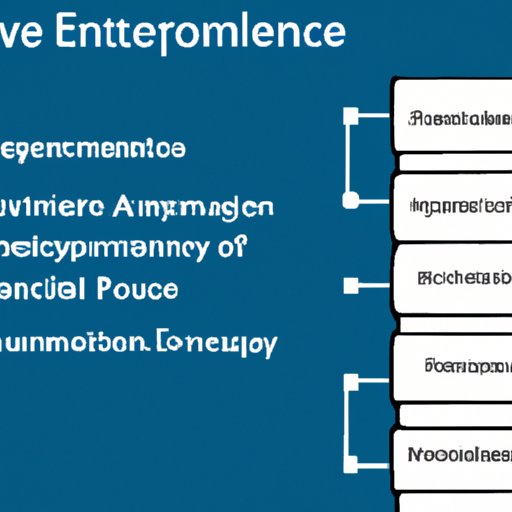Introduction
Reference architectures are becoming increasingly important in the technology industry, providing a foundation for IT infrastructure and enterprise adoption. But what exactly is a reference architecture? In short, it’s a framework or set of standards that organizations can use to build their own IT systems and applications. This article will explore the concept of reference architecture in greater detail, examining the different types, benefits, and how organizations can leverage them for scalable solutions.
Exploring Reference Architectures: What Are They and How Can They Help?
A reference architecture is a blueprint for building a system or application that meets specific requirements. It’s designed to provide guidance on best practices and patterns for software development. According to Gartner, “a reference architecture is a repository that captures and organizes all the components and rules necessary to create an IT solution that meets business requirements.”
Reference architectures can be used to develop both standard and custom applications. They provide organizations with a structured approach to designing and deploying IT systems, helping to ensure that the end product meets the desired requirements. By leveraging reference architectures, organizations can reduce time to market, improve quality, and increase efficiency.
Understanding the Different Types of Reference Architectures
There are several different types of reference architectures, each of which has its own unique purpose and advantages. For example, the Open Group Architecture Framework (TOGAF) is a popular reference architecture used by many organizations. It provides a detailed structure for designing, planning, implementing, and governing IT systems. Other popular reference architectures include the Zachman Framework, which focuses on data management, and the Department of Defense Architecture Framework (DoDAF), which is designed for military applications.
In addition to these more established frameworks, there are also many industry-specific reference architectures. These include the National Information Exchange Model (NIEM) for government agencies, the Federal Enterprise Architecture (FEA) for federal agencies, and the Health Level 7 (HL7) standard for health care organizations.
Leveraging Reference Architecture for Scalable Solutions
Reference architectures can also be used to create scalable solutions. For example, a company may develop a reference architecture for its customer relationship management (CRM) system. This reference architecture will include a set of components that can be used to build a CRM system that can easily scale up or down as needed. This means that the company can quickly add new features or services without having to completely rebuild the system from scratch.
Reference architectures can also help organizations ensure that their IT systems are secure and compliant. By following a set of standards and best practices, organizations can ensure that their systems meet regulatory requirements and adhere to industry standards.
A Comprehensive Guide to Reference Architecture
Now that we’ve explored the basics of reference architecture, let’s take a closer look at how organizations can use them to build successful IT systems. Here are some key steps to consider when creating a reference architecture:
Building a Foundation for Your IT Infrastructure
The first step in creating a reference architecture is understanding your organization’s needs. This includes identifying the goals, objectives, and requirements of the project. Once you have a clear understanding of the project’s scope, you can begin to develop a roadmap that outlines the steps you need to take to implement the reference architecture. This roadmap should include the technology and processes you’ll need to deploy, as well as the timeline for implementation.
Once you’ve created the roadmap, you can begin to build the foundation for your IT infrastructure. This involves selecting the appropriate technologies and designing the architecture to meet your organization’s specific needs. It’s important to keep in mind that the reference architecture should be flexible enough to accommodate future changes and growth.
The Key to Successful Enterprise Adoption
Once you’ve built the foundation for your IT infrastructure, the next step is to ensure that it’s adopted across the enterprise. This requires a comprehensive strategy that includes executive buy-in, training, and support. To ensure that users understand the reference architecture and are able to use it effectively, you may need to provide additional resources such as documentation, tutorials, and training materials.
It’s also important to ensure that the reference architecture is regularly updated to reflect changes in technology and trends. This helps to ensure that the architecture remains relevant and useful for the organization.
Conclusion
Reference architectures are an important tool for organizations looking to build successful IT systems. They provide a structured approach to developing and deploying IT systems, helping to ensure that the end product meets the desired requirements. By leveraging reference architectures, organizations can reduce time to market, improve quality, and increase efficiency.
By following the steps outlined in this article, organizations can create a comprehensive reference architecture that meets their specific needs. With a well-defined architecture in place, organizations can ensure that their IT systems are secure, compliant, and scalable.
From improving quality to reducing time to market, reference architectures offer a range of benefits for organizations. By understanding and leveraging these benefits, organizations can create robust IT systems that meet their specific requirements.
(Note: Is this article not meeting your expectations? Do you have knowledge or insights to share? Unlock new opportunities and expand your reach by joining our authors team. Click Registration to join us and share your expertise with our readers.)
